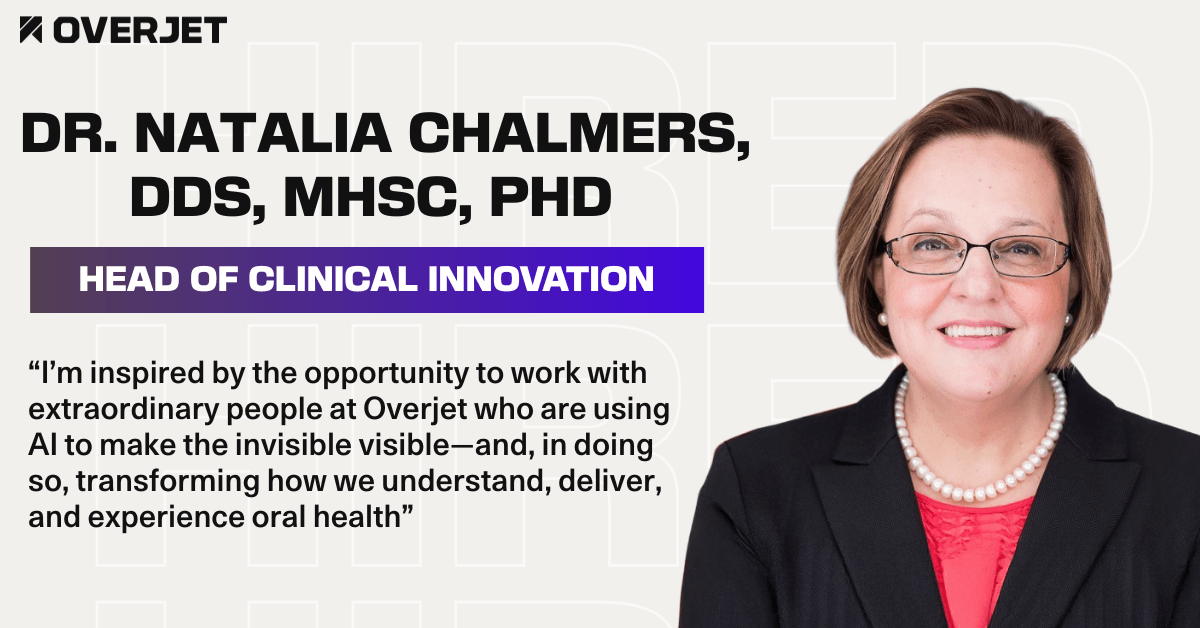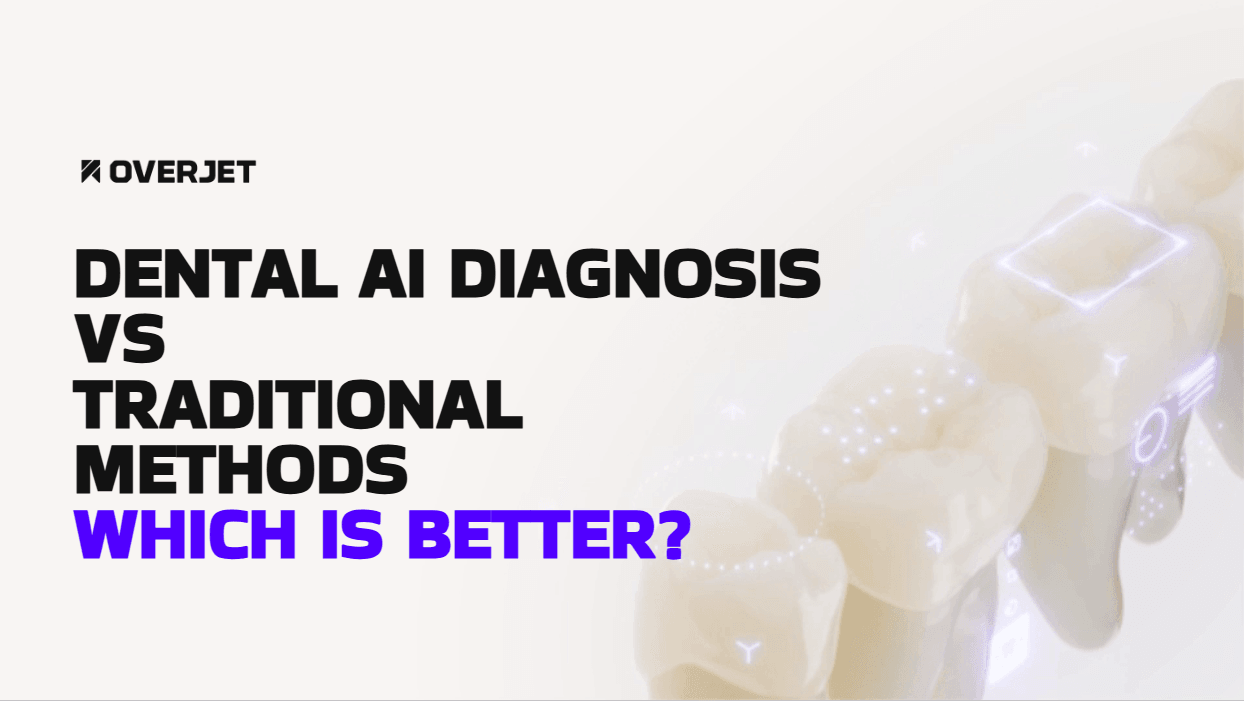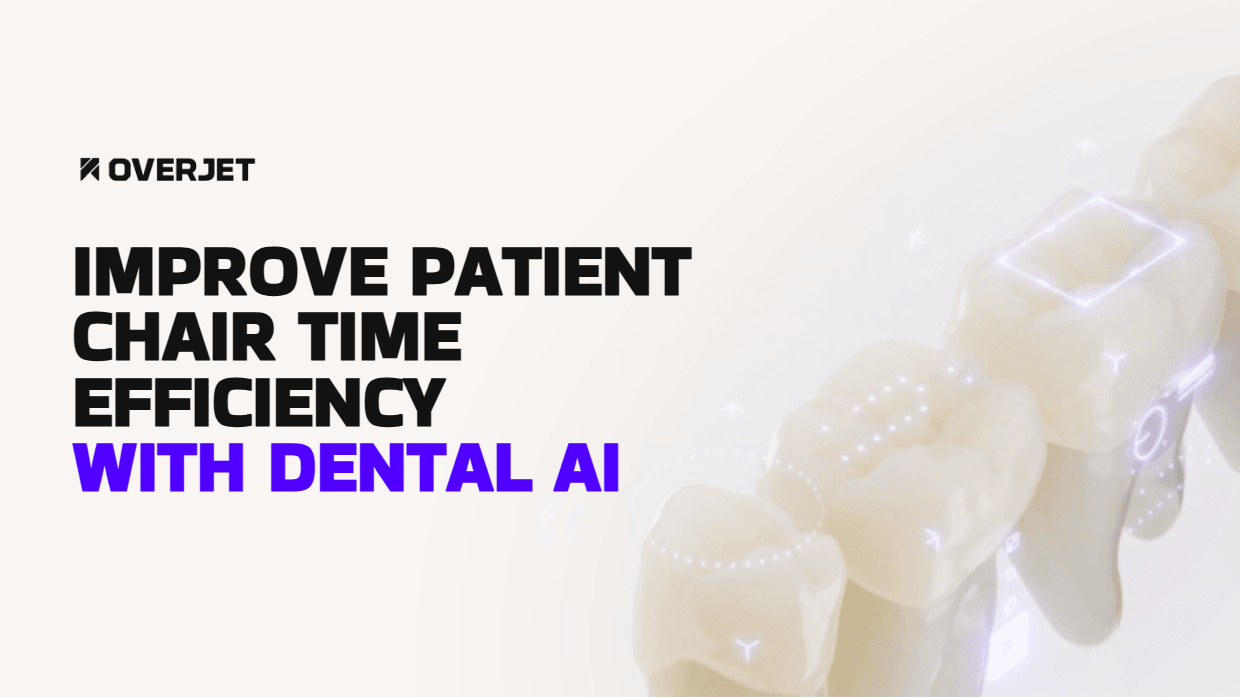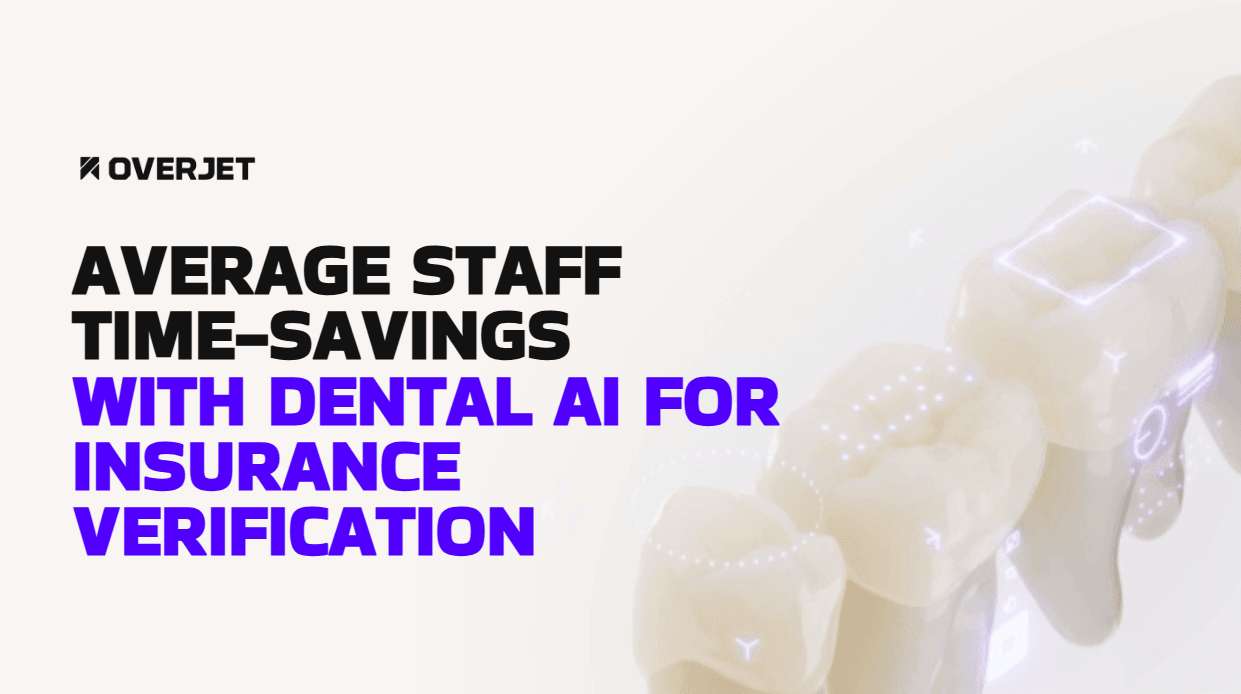Writing dental insurance narratives often determines whether your claims get approved on first submission or languish in review for weeks. A well-crafted narrative transforms basic procedure codes into compelling clinical stories that justify medical necessity and expedite payment.
This guide walks you through each component insurers expect, provides procedure-specific examples, and shows how AI-powered documentation can streamline your workflow while improving approval rates.
Explore Overjet's Dental AI Software
What Is a Dental Insurance Narrative?
A dental insurance narrative is a written explanation that accompanies your insurance claim, providing clinical context and medical necessity for proposed treatments. To write a strong dental narrative, you must be specific, document the medical necessity, and include clinical evidence to support the procedure—exactly what insurance reviewers look for when evaluating claims.
Think of the narrative as storytelling that connects your patient’s clinical condition to your treatment recommendation. While claim forms capture basic procedure codes and fees, the narrative explains why this specific patient needs this particular treatment right now.
Why Clear Narratives Matter for Claim Approval and Patient Care
Well-written narratives dramatically improve your approval rates while reducing time-consuming back-and-forth communications with insurers. When reviewers can clearly understand the clinical justification, they approve claims on first submission more often.
Beyond administrative benefits, approved claims mean your patients receive timely care without financial delays. This creates a smoother experience that builds trust and allows you to focus on clinical excellence rather than insurance hassles.
Required Data Elements Every Payer Expects
Insurance companies consistently look for specific information in every narrative, regardless of the procedure type. Missing any of these elements often triggers automatic denials or requests for additional information.
Tooth Numbers and Surfaces
Always specify the exact tooth location using the universal numbering system (1-32 for permanent teeth). Include affected surfaces using standard abbreviations: mesial (M), distal (D), facial (F), lingual (L), and occlusal (O).
For example, write “Tooth #19 with extensive MO decay” rather than “back tooth needs filling.” This precision helps reviewers quickly locate the problem area and understand the scope of treatment.
Objective Clinical Findings and Diagnosis
Document measurable clinical observations that support your diagnosis. Include probing depths, mobility scores, radiographic findings, and visual examination results using standard dental terminology.
Replace subjective descriptions like “tooth looks bad” with specific findings such as “3mm vertical fracture extending subgingivally on the facial aspect.” Objective measurements provide concrete evidence that reviewers can evaluate consistently.
Radiographic or Photo Evidence References
Reference attached imaging that supports your narrative claims. Modern AI-enhanced imaging platforms like Overjet provide clearer documentation by automatically highlighting pathology and annotating key findings.
When referencing images, be specific: “Bitewing radiograph shows radiolucency extending into the pulp chamber” rather than simply “see attached X-ray.” This guides the reviewer’s attention to relevant findings.
Previous Treatment or Restorations
Document the patient’s treatment history, including failed restorations, previous procedures, and their outcomes. This context helps justify why current treatment is necessary despite past interventions.
Include timeframes when possible: “Large amalgam restoration placed in 2018 now shows recurrent decay and marginal breakdown.” This timeline demonstrates that sufficient time has passed to warrant replacement.
Planned Procedure and Prognosis
Clearly describe your proposed treatment and expected outcomes. Connect the procedure choice directly to your clinical findings, showing logical progression from diagnosis to treatment plan.
Explain why alternative treatments aren’t appropriate: “Root canal therapy indicated due to irreversible pulpitis; direct restoration insufficient given extent of decay.” This demonstrates thorough treatment planning.
Step-By-Step Process for Writing Dental Narratives That Work
Following a systematic approach ensures you don’t miss critical elements that could delay claim processing. This sequence works whether you’re writing your first narrative or your thousandth.
1. Verify Coverage Inclusions and Exclusions
Before writing anything, check the patient’s specific plan benefits and limitations. Some procedures require pre-authorization, while others have waiting periods or frequency limitations that affect approval timing.
Understanding coverage details helps you frame the narrative appropriately. If a procedure has limited coverage, emphasize medical necessity more strongly to justify the exception.
2. Gather AI-Annotated Images and Charts
Collect all supporting documentation before you start writing. This includes radiographs, intraoral photos, periodontal charts, and any diagnostic test results relevant to your treatment plan.
Overjet’s AI annotations can highlight pathology automatically, making it easier to reference specific findings in your narrative. Enhanced images provide clearer evidence that supports your clinical decision-making.
3. Draft Concise Patient-Specific Narrative
Write a unique narrative that reflects this patient’s individual clinical situation. Avoid generic templates that insurers easily recognize—each narrative tells a specific patient’s story.
Start with the patient’s chief complaint, then describe your clinical findings, and conclude with your treatment recommendation. This logical flow helps reviewers follow your clinical reasoning.
4. Insert CDT Codes and Supporting Metrics
Include relevant procedure codes with supporting measurements that justify the treatment level. For example, reference specific probing depths for periodontal procedures or caries extent for restorative work.
Objective metrics strengthen your case by providing quantifiable evidence. Instead of writing “deep pockets,” specify “7-8mm probing depths with bleeding on probing.”
5. Review Terminology and Tone
Use professional dental language while avoiding emotional appeals or subjective descriptions. Focus on clinical facts that establish medical necessity rather than patient preferences or cosmetic desires.
Replace phrases like “patient wants” with “clinical findings indicate.” This shift emphasizes medical necessity over elective treatment, which insurers approve more readily.
6. Attach Required Files and Submit
Double-check that all referenced documentation is included and properly labeled. Verify file formats meet the insurer’s requirements—some accept only specific image types or file sizes.
Missing attachments are a common cause of claim delays, so create a checklist to ensure completeness before submission.
Procedure-Specific Narrative Examples and Templates
Note: According to the New York State Medicaid Dental Program’s January 31, 2024 update, certain procedures such as unopposed third molars may not require narratives in specific circumstances. Always verify current Medicaid guidelines for payer-specific requirements to ensure efficient documentation and avoid unnecessary submissions.
Different procedures require different approaches to narrative writing. While you want to avoid generic templates, understanding the key elements for common procedures helps ensure completeness.
Crown narratives: Focus on structural integrity and function restoration
SRP narratives: Require specific periodontal measurements and disease documentation
Root canal narratives: Center on pulp vitality and pain symptoms
Implant narratives: Address tooth replacement necessity and site adequacy
Crown Narrative Sample for Fractured Tooth
“Patient presents with spontaneous pain on tooth #30 following trauma two weeks ago. Clinical examination reveals a vertical fracture extending from the mesio-occlusal cusp tip to 2mm subgingivally on the lingual aspect. Existing MOD amalgam restoration compromises 60% of remaining coronal tooth structure.”
“Bitewing radiograph confirms fracture line and shows no periapical pathology. Full coverage restoration necessary to protect remaining tooth structure and restore function.”
SRP Narrative Sample With Periodontal Charting
“Patient exhibits generalized chronic periodontitis with localized areas of severe bone loss. Periodontal charting reveals 5-8mm probing depths throughout posterior quadrants with bleeding on probing and suppuration.”
“Radiographs show horizontal bone loss ranging from 30-50% in affected areas. Scaling and root planing required to eliminate bacterial deposits and establish periodontal health.”
Root Canal Narrative Sample for Irreversible Pulpitis
“Patient reports severe spontaneous pain on tooth #3 for the past week, worsening with hot stimuli. Cold testing produces lingering pain lasting 45 seconds, indicating irreversible pulpitis.”
“Periapical radiograph shows deep carious lesion approaching the pulp chamber with slight widening of the PDL space. Endodontic therapy indicated to eliminate infection and preserve tooth.”
Implant Narrative Sample After Trauma
“Tooth #8 was avulsed due to sports trauma six months ago, with immediate extraction site preservation performed. Clinical examination shows adequate keratinized tissue and bone width of 7mm.”
“CBCT confirms 12mm of vertical bone height with no anatomical limitations. Single tooth implant placement indicated to restore function and prevent adjacent tooth migration.”
Bridge Narrative Example for Missing #19
“Patient missing tooth #19 following extraction due to vertical root fracture eight months ago. Adjacent teeth #18 and #20 are sound with adequate crown height and root support.”
“Occlusal analysis reveals supraeruption of opposing tooth #2 and mesial drift of #20. Three-unit bridge necessary to restore posterior occlusion and prevent further tooth movement.”
Crown Lengthening Narrative Example
“Tooth #30 requires crown lengthening prior to final restoration placement. Existing crown margins violate biologic width by 2mm, causing chronic inflammation and bleeding.”
“Periodontal probing reveals 2mm of attached gingiva with adequate bone levels. Surgical crown lengthening indicated to establish proper biologic width and enable long-term restoration success.”
Occlusal Guard Narrative Example for Bruxism
“Patient exhibits severe bruxism with documented tooth wear on all posterior teeth. Clinical examination reveals flattened cusps and exposed dentin on molars and premolars.”
“Patient reports morning jaw pain and headaches consistent with nocturnal grinding. Occlusal guard fabrication necessary to protect remaining tooth structure and reduce TMJ symptoms.”
Common Wording Pitfalls and Denial Triggers to Avoid
Certain phrases and approaches consistently trigger claim denials or requests for additional information. Recognizing patterns helps you avoid unnecessary delays.
Cosmetic language: Avoid phrases like “esthetic improvement” or “patient desires whiter teeth”
Vague descriptions: Replace subjective terms like “tooth is bad” with specific clinical findings
Template phrases: Insurers recognize generic wording from repeated use across multiple claims
Emotional appeals: Focus on clinical necessity rather than patient distress
Instead of writing “patient in severe pain,” document “irreversible pulpitis confirmed by cold testing.” This approach emphasizes objective findings over subjective complaints.
Automating Narratives With AI-Driven Imaging and Data From Overjet
IRIS represents the newest iteration of smart imaging software, combining crystal-clear image capture with FDA-cleared AI analysis capabilities.
Modern AI platforms streamline narrative creation by automatically detecting pathology and generating supporting documentation. Overjet’s imaging technology identifies caries, bone loss and other conditions with high accuracy, providing objective findings you can reference in narratives.
This automation reduces the time spent gathering evidence while improving documentation quality. AI-detected findings carry additional weight with insurers because they represent standardized, objective measurements rather than subjective clinical impressions.
Integration with practice management systems allows seamless workflow from diagnosis to claim submission. You can generate narratives directly from AI-annotated images, ensuring consistency between clinical findings and insurance documentation.
Final Checklist Before You Submit the Claim
Review each narrative against specific criteria to maximize approval chances:
Patient specificity: The narrative reflects this individual’s unique clinical situation, not a generic template
Supporting documentation: All referenced images, charts, and test results are properly attached and labeled
Procedure justification: Medical necessity is clearly established through objective clinical findings
Professional tone: Language is appropriate for insurance review without emotional appeals
Completeness: All required data elements are included with specific measurements and findings
Create a standardized review process where a second team member checks narratives before submission. Fresh eyes often catch missing elements or unclear phrasing that could delay approval.
Drive Faster Approvals With Overjet’s AI Narrative Toolkit
Overjet’s comprehensive AI platform transforms narrative writing from a time-consuming task into an efficient, evidence-based process. The system’s pathology detection capabilities provide objective findings that strengthen your clinical documentation while reducing manual review time.
By combining AI-powered imaging analysis with streamlined workflow integration, Overjet helps practices achieve higher approval rates and faster payment cycles. This efficiency allows you to focus on patient care while maintaining the thorough documentation that insurers require.
Ready to experience how AI can streamline your narrative process and improve claim approvals?
Ready to See Overjet's Dental AI in Action?
Frequently Asked Questions (FAQs)
How long should a dental insurance narrative be?
Dental narratives work best when they’re concise yet comprehensive, typically ranging from one to three paragraphs depending on procedure complexity. Focus on including all essential clinical information without unnecessary detail that might confuse reviewers.
Can I reuse narrative wording from previous patients?
Each narrative must be patient-specific and reflect individual clinical findings, as insurers can detect template language and may deny claims for generic wording. Always customize narratives to match the unique clinical presentation and treatment history of each patient.
Which clinical measurements strengthen narrative approval rates?
Include specific measurable findings like probing depths, mobility scores, radiographic bone loss percentages, and caries extent measurements. Objective clinical data provides concrete justification for proposed treatments and reduces subjective interpretation by insurance reviewers.









